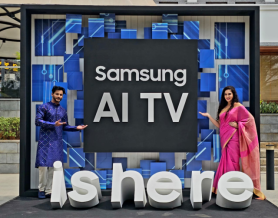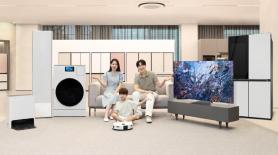
[Courtesy of Samsung]
SEOUL -- Amid its intensifying rivalry with OLED (organic light-emitting diode) TVs, Samsung Electronics showcased its new premium QLED TV installed with an artificial intelligence voice-recognition system that provides easy control.
"We will open up a new era of intelligent displays with QLED TVs," Han Jong-Hee, president of Samsung's visual display business, said in a media event, adding Samsung's new QLED TVs feature clear picture quality regardless of the surrounding environment or the brightness of contents.
The event came as Samsung's domestic rival, LG, this week started global sales of new OLED TVs equipped with its AI platform DeepThinQ. Samsung uses its smartphone AI platform, Bixby, and quantum-dot technology for QLED TVs.
Han said Samsung's new QLED TVs contained two elements -- connectivity with consumers and entertainment -- along with their beautiful design and an application that connects to other devices through Internet-of-Things (IoT) technology.
"In the future, TV should be an intelligent display that offers consumers the best value without being bound by the surrounding environment, contents, or device connectivity," he said. "QLED TVs with the highest picture quality and various innovations will lead this market change."
Samsung's new QLED TVs are backed by a magic screen feature which displays various information from news to photos even when not in use, and the "magic" cable system that combines different connecting lines used by TVs into one.
The world's largest smartphone maker plans to release 17 QLED TV models at home this year, focusing on large TVs. The price tag of 55-inches stands at 2.79 million won (2,607 US dollars) and 75-inches are priced at 10.4 million won.
Samsung will maintain the two-track production of QLED and MicroLED TVs, he said, adding the mass production of MicroLED TVs is planned at the Vietnam plant. MicroLED TV uses tiny LEDs which have red, green, and blue sub-pixel that can produce light. Because MicroLED TV panels have a higher density than normal LED TVs, MicroLED TV is suitable for displaying ultra-high-resolution video contents.
Samsung argues QLED panels maintain their color reproduction range for a long time because they use inorganic materials while OLED displays lose brightness. LG insists OLED can achieve the best picture quality with relatively low luminance thanks to its ability to deliver perfect blacks.
Copyright ⓒ Aju Press All rights reserved.



